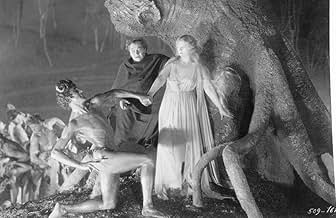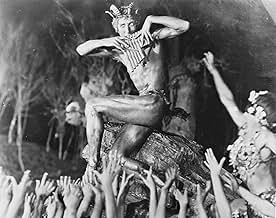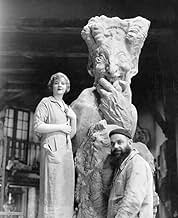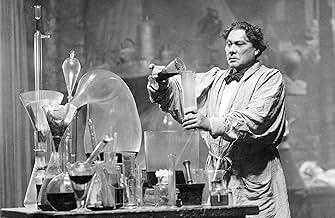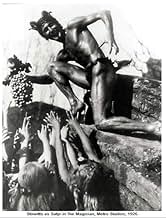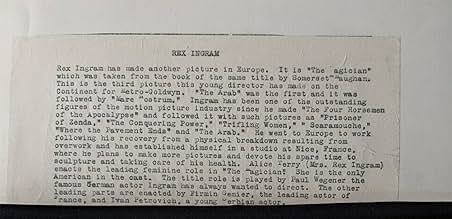A magician/alchemist, seeking to create life, finds that he needs the "blood of a virgin" to continue his experiments. He sends out his dwarf assistant to pick out the right girl.A magician/alchemist, seeking to create life, finds that he needs the "blood of a virgin" to continue his experiments. He sends out his dwarf assistant to pick out the right girl.A magician/alchemist, seeking to create life, finds that he needs the "blood of a virgin" to continue his experiments. He sends out his dwarf assistant to pick out the right girl.
Hubert I. Stowitts
- Dancing Faun
- (as Stowitts)
Claude Fielding
- Dancing Faun
- (uncredited)
Gerald Fielding
- Dancing Faun
- (uncredited)
Rosita Garcia
- Arab Girl Bitten by Snake
- (uncredited)
John George
- Haddo's Dwarf Servant
- (uncredited)
Michael Powell
- Man with Balloon at Snake Charming
- (uncredited)
- Director
- Writers
- All cast & crew
- Production, box office & more at IMDbPro
Featured reviews
I read Carlos Clarens "Horror Movies" in '68 and it was one of the bigger influences on my movie tastes (as was seeing my first movie "House on Haunted Hill" in the theater with Emergo when I was five years old) so I'm inclined to recommend this movie for those who would like a fluid distillation of what was best about the silent cinema.
I saw it at the Film Forum in NYC around '92 or '93. Ingram had moved to France and The Magician is notable for its documentary footage of Paris, Monaco and the French countryside. Wegener is a formidably grotesque presence and there is a remarkable set piece at the very beginning when a huge clay sculpture collapses, seeming at first to come to life, sending Alice Terry to the hospital. Oliver Haddo, the magician of the title, lurks in the observation gallery as a life saving operation is performed on her...
This movie really has it all so don't miss it if you get the chance especially if you can see it with live musical accompaniment.
I saw it at the Film Forum in NYC around '92 or '93. Ingram had moved to France and The Magician is notable for its documentary footage of Paris, Monaco and the French countryside. Wegener is a formidably grotesque presence and there is a remarkable set piece at the very beginning when a huge clay sculpture collapses, seeming at first to come to life, sending Alice Terry to the hospital. Oliver Haddo, the magician of the title, lurks in the observation gallery as a life saving operation is performed on her...
This movie really has it all so don't miss it if you get the chance especially if you can see it with live musical accompaniment.
This is a very good silent film that still hold up very well today. When the film begins, Margaret (Alice Terry) is terribly injured--so badly she's paralyzed. However, Dr. Burdon (Iván Petrovich) performs surgery on her and she is healed. They soon fall in love and life looks grand. However, Oliver Haddo (Paul Wegener) sees her and instantly is smitten with her. Using his evil magical powers, he's able to pull her to him despite he loving the Doctor. However, he's not taking her because he loves her...nope. He's planning on using her for a human sacrifice in order to act like a Dr. Frankenstein and prove he can raise the dead!! Can Dr. Burdon rescue his love before it's too late?
This is a good film...very tense and exciting. Wegener (the German actor who starred in "The Golem") was excellent as the powerful madman and the film, though melodramatic, avoids going overboard like some films of the era thanks to good direction by Rex Ingram....Terry's real life husband.
This is a good film...very tense and exciting. Wegener (the German actor who starred in "The Golem") was excellent as the powerful madman and the film, though melodramatic, avoids going overboard like some films of the era thanks to good direction by Rex Ingram....Terry's real life husband.
In the 1920s films dealing with supernatural evil were extremely rare. However, director Rex Ingram, obviously influenced by earlier German forays into the supernatural, cast German actor Paul Wegener of DER GOLEM in this adaptation of Somerset Maugham's novel THE MAGICIAN. Wegener's menacing performance as an evil Yogi in LEBENDE BUDDHAS (1925) made him a good choice to play Oliver Haddo, obsessed with creating life from an ancient formula requiring the heart's blood of a maiden, played by Ingram's wife Alice Terry.
John F. Seitz' cinematography is superb, especially in the depiction of the heroine's hallucinatory descent into Hell where she is figuratively ravished by a lustful and athletic satyr. And although Haddo doesn't succeed in creating the grisly, half-complete humans as in the novel, the controversial subject matter was nevertheless strong enough to insure the film's failure at the box-office in 1926.
Interesting comparisons have been made between this film and James Wale's FRANKENSTEIN, but the subject of black magic also invites comparison with later films - THE BLACK CAT (1934), THE NIGHT OF THE DEMON (1957), and THE DEVIL RIDES OUT (1968) - featuring characters who like Oliver Haddo were modeled on real-life occultist Aleister Crowley.
John F. Seitz' cinematography is superb, especially in the depiction of the heroine's hallucinatory descent into Hell where she is figuratively ravished by a lustful and athletic satyr. And although Haddo doesn't succeed in creating the grisly, half-complete humans as in the novel, the controversial subject matter was nevertheless strong enough to insure the film's failure at the box-office in 1926.
Interesting comparisons have been made between this film and James Wale's FRANKENSTEIN, but the subject of black magic also invites comparison with later films - THE BLACK CAT (1934), THE NIGHT OF THE DEMON (1957), and THE DEVIL RIDES OUT (1968) - featuring characters who like Oliver Haddo were modeled on real-life occultist Aleister Crowley.
Its all here in embryo: the paradigm for Frankenstein. The mad scientist, trying to create life in his laboratory located in a forbidden tower on the top of a rocky mountain, while thunder and lightning terrify the superstitious villagers. Supposedly adapted from a W. Somerset Maugham novel, the possibility exists that it was Maugham (a qualified physician) who, still very much on the make for an overwhelming success in his third book, might have cribbed more than a little bit from Mary Shelly. However, instead of the Romantic Prometheus, driven mad by hubris and symbolic of mankind's desire to harness newfangled science to dominate and conquer nature, despite the warnings of terrible consequences, all taking place on the edge of the Industrial revolution, we have the elements shaped into a Victorian melodrama of the villain-continued-to-pursue-her variety complete with virgin's blood and a heroine tied in artful knots, and a villain motivated by nothing more than criminal insanity.
On the other hand the artful visual qualities of the storytelling is something that has been lost in today's film vocabulary. A zippy 80 minutes or so, today the coarse need for thrills from this type of film would have necessitated a number anatomically gruesome murders before the final heroine jeopardy and heroic rescue. Here a little horror goes a very long way (all the way to the French Riviera, in fact). THE MAGICIAN is everything that made the silent film, at the same time, so great and so very silly. By the way, shots of Paris, virtually traffic free are a revelation, as are shots of a cobblestone village high up in the mountains (the Alps Maritimes) behind the Riviera. And yes, that's the same Paul Wegener who directed and starred in two versions of The Golom as well as playing Svengali in a 1927 version of the Du Maurier story.
On the other hand the artful visual qualities of the storytelling is something that has been lost in today's film vocabulary. A zippy 80 minutes or so, today the coarse need for thrills from this type of film would have necessitated a number anatomically gruesome murders before the final heroine jeopardy and heroic rescue. Here a little horror goes a very long way (all the way to the French Riviera, in fact). THE MAGICIAN is everything that made the silent film, at the same time, so great and so very silly. By the way, shots of Paris, virtually traffic free are a revelation, as are shots of a cobblestone village high up in the mountains (the Alps Maritimes) behind the Riviera. And yes, that's the same Paul Wegener who directed and starred in two versions of The Golom as well as playing Svengali in a 1927 version of the Du Maurier story.
Practically every element of this film holds up very well here in the twenty-first century, eighty-four years after the movie was made - the writing, the casting, the directing (and art direction), the photography (both indoor and outdoor), the "costumes" and "sets" (really, the fashions and architecture of the era were a captivating delight), and most of the acting. I say "most" because the only thing that seemed dated in this post-feminist era was the woe-is-me attitude of the hapless heroine.
Particularly well-cast in terms of "looking the part" were the two male leads, both protagonist and antagonist. (After all, these were not speaking parts, so look was of high importance.)
Surprisingly enjoyable were some quite subtle, non-intrusive comedic tension-breakers by peripheral characters, including some clever silent movie sight gags.
The main recommendation I can make for seeing this film, however, is the clarity of the photography, both for the close-ups, and for some wonderful outdoor set pieces.
Particularly well-cast in terms of "looking the part" were the two male leads, both protagonist and antagonist. (After all, these were not speaking parts, so look was of high importance.)
Surprisingly enjoyable were some quite subtle, non-intrusive comedic tension-breakers by peripheral characters, including some clever silent movie sight gags.
The main recommendation I can make for seeing this film, however, is the clarity of the photography, both for the close-ups, and for some wonderful outdoor set pieces.
Did you know
- TriviaThis movie, especially the explosion of the laboratory, influenced James Whale while making the Frankenstein (1931) movies.
- Quotes
Dr. Arthur Burdon: Your niece is certainly the most beautiful patient I have ever had.
Details
- Runtime
- 1h 23m(83 min)
- Sound mix
- Aspect ratio
- 1.33 : 1
Contribute to this page
Suggest an edit or add missing content

